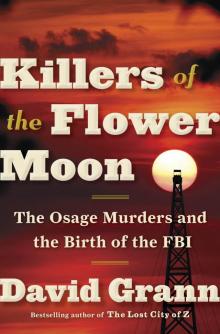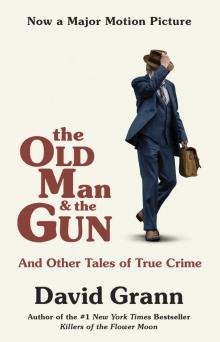- Home
- David Grann
The Old Man and the Gun Page 2
The Old Man and the Gun Read online
Page 2
They began to hit one bank after another. After one heist, witnesses said the last thing they saw was a row of suits hanging in the back seat of the getaway car. The heists, which continued for two years, dominated the local headlines, often preempting coverage of the 1952 Presidential election and the McCarthy hearings. Tucker and Bellew were depicted as “armed men” who “terrorized” their “victims,” but also as “dramatically attired” “hold-up artists” who “expertly stripped” the tellers of cash, leaving behind “only an impression of competent banditry…and one getaway car.”
On March 20, 1953, more than two years after Tucker’s escape from the hospital, F.B.I. agents surrounded him as he was retrieving loot from a safe-deposit box in San Francisco. Then they went to search the place Tucker had listed as his residence. There, in a spacious apartment in San Mateo, they found a young blond woman who said she had never heard of Forrest Tucker. She was married to a wealthy songwriter, she said, who commuted daily to the city, and they had just moved into a bigger apartment to make room for their five-month-old son. Her husband’s name, she told the police, was Richard Bellew. Yet when the officers showed Shirley Bellew a photograph of the bank robber and longtime prison fugitive Forrest Tucker, she burst into tears. “I can’t believe it,” she said. “He was such a good man, such a good provider.”
She recalled how her husband would come home every night and play with their baby, whom they had named Rick Bellew, Jr. “What’s going to become of our little baby?” she asked. “What’s his name going to be?”
* * *
—
“Let me tell you about Alcatraz,” Tucker said one day as he sat in the corner of the visiting room, his walker resting against his leg. He had spread a napkin out in front of him and was eating a meatball hero I’d brought him and sipping a Dr Pepper. “There were only fifteen hundred and seventy-six people who ever went there. I was No. 1047.”
Alcatraz, or “the Rock,” had been converted from a military prison in 1934 as a way to confine the country’s most notorious criminals, including George (Machine Gun) Kelly, Robert Stroud (the Birdman of Alcatraz), and Mickey Cohen. At least half of the inmates had previously attempted to break out of other prisons. Surrounded by the freezing San Francisco Bay and its deadly currents, it was built to be escape-proof. Al Capone, who was sent there in 1934, is said to have told the warden, “It looks like Alcatraz has got me licked.”
Tucker arrived on September 3, 1953. He was thirty-three. He had been sentenced to thirty years. In his prison photo, he still has on a jacket and tie; his brown hair is brushed back with a touch of oil; he is slightly unshaved but still striking. Within moments, he was stripped naked, and a medical attendant probed his ears and nose and mouth and rectum, searching for any tools or weapons. He was given a blue chambray shirt with his number stamped on it and a pair of trousers, as well as a cap, a peacoat, a bathrobe, three pairs of socks, two handkerchiefs, a pair of shoes, and a raincoat. His cell was so narrow that he could reach out and touch both sides at the same time. “It was so cold in the cellblock you had to sleep with your coat and hat to stay warm,” Tucker says.
As he lay in bed, he says, he thought about his wife and child. He remembered the first time he met Shirley Storz, at an event for singles in Oakland. He remembered how they skied at Lake Tahoe and were married in a small ceremony in September of 1951, how she sang in a choral group, and how he’d sit and listen for hours. And he remembered his son being born. “We loved each other,” Tucker says of his wife. “I didn’t know how to explain to her the truth—that this was my way of life.”
Several weeks after he arrived, a guard roused him from his cell and led him into a tiny room that had a small window. Peering through it, he saw his wife sitting on the other side. He picked up the phone. “It was hard to talk,” he recalls. “We had to look at each other through a piece of glass. She told me she had to make a life for herself. I said, ‘The best thing you can do is make a life for you and our son.’ I told her, ‘I won’t bother you no matter what, no matter how much I want to. I won’t ring your phone.’ ” A few months later, he received notice that their marriage had been annulled.
By now, Tucker had developed several maxims, including “The more security, the more bizarre the method of escape must be.” He began to concoct elaborate schemes with a fellow inmate named Teddy Green, an escape artist and bank robber who had once dressed as a priest to elude the police and had broken out of the state penitentiary by shipping himself out in a box of rags.
Along with another inmate, they started smuggling tools from their prison jobs, hiding them in the laundry, and planting pieces of steel wool on other prisoners to set off the metal detectors, so that the guards assumed they were broken. They carved holes in their toilet bowls and tucked the tools inside, putting putty over them. At night, they used the tools to tunnel through the floor, planning to go out by means of the basement.
One day, according to internal prison records, a prisoner in solitary suggested that guards examine the cell toilets; soon a full-scale search was launched. A warden’s report summed up the findings:
The result of the shakedown of these toilets was the blow torch as I have mentioned, a bar spreader, a pair of side cutters, a brace and some bits…a screwdriver and one or two pieces of wire and a piece of carborundum stone.
All three prisoners were labelled “very dangerous escape risks” and locked in the Treatment Unit, better known as “the hole.”
“I remember walking in with no clothes or shoes on,” Tucker says. “The steel floor was so cold it hurt to touch it. The only way to stay warm was to keep walking.” One night, he heard a haunting sound through the window. He couldn’t see anyone outside, but he heard voices from below. They were the guards’ children, singing carols. “It was the first children’s voices I had heard in years,” he says. “It was Christmas Eve.”
* * *
—
As the time passed, Tucker began to teach himself the law, and before long he was deluging the court with appeals, which he wrote in a slanting methodical print. Although a prosecutor later dismissed one of his writs as pure “fantasy,” he was granted a hearing in November of 1956. According to Tucker, as well as court records, the night before his court appearance, while being held in the county jail, he complained of pains in his kidneys and was rushed to the hospital. Guards were stationed at every door. When no one was looking, Tucker broke a pencil and stabbed his ankle. Because of the wound, the guards removed his leg irons, strapping him to the gurney with his hands cuffed. As he was being wheeled into the X-ray room, Tucker leaped up, overpowered two guards, and ran out the door. For several hours, he enjoyed the fresh air and the sight of ordinary people. He was apprehended, still in his hospital gown and handcuffs, in the middle of a cornfield.
The brief escape, for which he was tried and convicted, enhanced his reputation as an escape artist. Yet it was not for another twenty-three years, after Tucker had been released and arrested again for armed robbery, that he made his greatest escape. In the summer of 1979, while at San Quentin, a maximum-security facility that jutted out into the ocean and was known among cons as “the gladiator school,” Tucker took a job in the prison industries and, with the help of two other inmates, John Waller and William McGirk, secretly gathered together scraps of wood and sheets of Formica, which they cut into strange shapes and hid under tarps. From the electrical shop, they spirited away two six-foot poles and several buckets. Then, in the furniture workshop, they found the final pieces: plastic dustcovers, paint, and tape, which they stored in boxes labelled “Office Supplies.”
On August 9th, after months of preparation, Tucker exchanged nods with both of his confederates in the yard, signalling that everything was ready. While Waller and McGirk stood watch outside the lumber shop, Tucker drew on his childhood experience and began to fashion the pieces into a fourteen-foot kayak. “A hammer was too
loud, so I had to use only tape and bolts,” Tucker says. He had just enough paint for one side of the craft, the side that would face the guard towers, and as the others urged him to hurry he stencilled on it “Rub-a-Dub-Dub.” Waller, who called the fifty-nine-year-old Tucker “the old man,” later told a reporter from the Los Angeles Times, “The boat was beautiful; I wish my eyes were as blue as that boat.”
They wore sailor hats and sweatshirts that Tucker had painted bright orange, with the logo of the Marin Yacht Club, which he had seen on the boats that sailed by. When the guard wasn’t looking, they hurriedly put the kayak into the water. As they set out, the winds were blowing more than twenty miles an hour, and massive swells began to swamp the kayak. “The boat didn’t leak a drop,” Waller said. “We could have paddled to Australia. It was those damn waves over the side. When we finally reached the edge of the property at Q”—San Quentin—“the son of a bitch sank.”
A guard in one of the towers spotted them clinging to the upside-down craft, kicking to shore, and asked if they needed help. They said they were fine, and, as if to prove it, McGirk held up his wrist and yelled, “We just lost a couple of oars, but my Timex is still running!” The guard, unaware that three prisoners were missing, laughed and went back to his lookout.
California soon unleashed a statewide manhunt. Meanwhile, police in Texas and Oklahoma began to report a strange series of holdups. They all had the same M.O.: three or four men would stroll into a grocery store or a bank, flash a gun, demand the money, and speed away in a stolen car. Witnesses invariably noted that they were all, by the standards of the trade, old men. One even wore what appeared to be a hearing aid. The authorities compared them to the elderly thieves in the film “Going in Style,” and dubbed them “the Over-the-Hill Gang.”
“That was when I was really a good robber,” Tucker tells me. He is careful not to admit to any particular crime (“I don’t know if they still have jurisdiction”) or implicate any of his living partners (“Some of them are still out there”), but he says that by the age of sixty he had at last mastered the art of the holdup.
* * *
—
One day, while we were sitting in the prison visiting room, Tucker leaned forward in his chair and began to teach me how to rob a bank. “First of all, you want a place near the highway,” he said, putting on his bifocals, his eyes blinking as if he were imagining a particular layout. “Then you need to case it—you can’t just storm in. You need to size it up, know it like your own home.”
“In the old days, the stickup men were like cowboys,” he continued. “They would just go in shooting, yelling for everyone to lie down. But to me violence is the first sign of an amateur.” The best holdup men, in his view, were like stage actors, able to hold a room by the sheer force of their personality. Some even wore makeup and practiced getting into character. “There is an art to robbing a bank if you do it right,” Tucker said. Whereas he once cultivated a flamboyant image, he later developed, he said, a subtler, more “natural” style.
“O.K., the tools,” he pressed on. Ideally, he said, you needed nail polish or superglue to cover your fingertips (“You can wear gloves, but in warmer climates they only draw attention”), a glass cutter, a holster, a canvas bag (“big enough for the dough”), and a gun (“a .38 or semi-automatic, or whatever you can get your hands on”). He said the gun was just “a prop,” but essential to any operation.
There was one other thing, he said after a pause. It was the key to the success of the Over-the-Hill Gang and what he still called “the Forrest Tucker trademark”: the hearing aid. It was actually a police scanner, he said, which he wired through his shirt; that way, he would know if any silent alarms had been triggered.
He removed a napkin from his pocket and wiped the sweat from his forehead. “Once you’ve got your cool car parked nearby, you’ve got your radio, your hands are covered with gloves or superglue, you walk in. Go right up to the manager. Say, ‘Sit down.’ Never pull the gun—just flash it. Tell him calmly you’re here to rob the bank and it better go off without a hitch. Don’t run from the bank unless you’re being shot at, ’cause it only shows something is going on. Just walk to the hot car, real calm, then drive to the cool car. Rev it up, and you’re gone.”
After he finished, he seemed satisfied. “I’ve just given you a manual on how to rob a bank,” he said. He reflected on this for a moment, then added, “No one can teach you the craft. You can only learn by doing.”
* * *
—
A forty-year-old sergeant on the Austin police force, John Hunt, was assigned to investigate the mysterious holdups of the Over-the-Hill Gang. “They were the most professional, successful robbers that I ever encountered in all my years on the force,” Hunt, who is now retired after a thirty-year career, told me. “They had more experience in robbery than we had catching them.”
Then a chain-smoker with a drooping mustache and a slight paunch, Hunt spent long days trying to catch the gang. With the advent of high-tech security, there were fewer and fewer traditional bank robbers; most were desperate drug addicts who made off with only a few thousand dollars before they were caught. The members of the Over-the-Hill Gang seemed to defy not just their age but their era. “They’d get up every day and be on the job,” Hunt said. “Just as a welder gets good at welding, or a writer gets good over the years by writing, these guys learned from their mistakes.”
In a one-year span, the Over-the-Hill Gang was suspected in at least sixty robberies in Oklahoma and Texas—twenty in the Dallas–Fort Worth area alone. The gang was also believed to be responsible for holdups in New Mexico, Arizona, and Louisiana. “SENIOR CITIZENS STRIKE AGAIN,” one headline blared. “MIDDLE-AGED BANDITS PUZZLE DETECTIVES,” another read.
In December of 1980, Hunt and forty other law-enforcement officers from at least three states held a conference in Dallas to figure out how to stop them. “You can’t say how many lives they altered by sticking a gun in someone’s face,” a former F.B.I. agent told me.
Tucker seemed unable to stop, no matter how much money he accumulated. Although there are no official estimates, Tucker—relying on an array of aliases, including Robert Tuck MacDougall, Bob Stone, Russell Johns, Ralph Pruitt, Forrest Brown, J. C. Tucker, and Ricky Tucker—is believed over his career to have stolen millions of dollars, a fleet of sports cars, a bag of yen, and one Sambo’s wooden nickel. In the spring of 1983, he embarked on his most audacious heist yet: robbing a high-security bank in Massachusetts in broad daylight by pretending that he and his men were guards making a routine pickup in an armored car. Tucker believed the plan was “a breakthrough in the art.” On March 7th, moments before the armored car was scheduled to arrive, they put on makeup and mustaches; Tucker’s wig had shrunk in a recent snowstorm, and rather than postpone the operation he decided to do without it.
The teller buzzed them in. Just as they were entering the vault, according to a police report, the manager noticed that “the dark mustache on one man and the white mustache on the other man were not real.” One of the “guards” patted his gun and said, “This is a holdup.”
Tucker locked the manager and two tellers inside the vault, and escaped with more than four hundred and thirty thousand dollars. But when the police showed the tellers a series of mug shots, they identified, for the first time, the leader of the Over-the-Hill Gang as the same man who had broken out of San Quentin in a homemade kayak three years earlier.
As the F.B.I., the local police, and the county sheriffs all tried to track him down, Tucker hid in Florida, checking in daily with Teddy Green, his old Alcatraz confidant. One June morning, Tucker pulled into Green’s garage and waited while his friend walked toward the car. “I was looking at him,” Tucker recalls, “thinking, My, what a sharp suit!”
A man jumped in front of Tucker’s car and yelled, “F.B.I., don’t move! You’re under arrest.”
Agent
s were everywhere, coming out of cars and bushes. Tucker glowered at Green, convinced that his friend had “ratted me out.” Although Tucker insists that he never had a pistol—and none was ever found—several agents said they saw one in his hand. “He’s got a gun!” one of them yelled, diving to the ground. The garage filled with the sound of gunfire. Bullets shattered the windshield and the radiator. Tucker, who had been hit in both arms and in the leg, ducked below the dashboard and pressed the accelerator, crashing outside the garage. He opened the car door and stumbled onto the street, his hands and face covered in blood. A woman with two children was driving toward him. “As I got closer,” the woman later testified, “he started to look bloodier and bloodier—it was all over him—and I thought, This poor man has been hit by a car.”
She offered him a ride, and he climbed into the passenger seat. Then, in her rearview mirror, she saw someone holding a rifle, and her six-year-old son cried out, “Criminal!” When she hesitated, Tucker grabbed the wheel and snapped, “I have a gun—now drive!” Her son began to sob. After a half-mile chase, they veered down a dead-end street. At a muttered “O.K.” from Tucker, the woman scrambled out of the car and dragged her children to safety. Then Tucker himself stepped from the car and passed out.
A columnist for the Miami Herald summed up the capture of the longtime prison fugitive and leader of the Over-the-Hill Gang this way:
There is something vaguely appealing about Tucker….Old guys are not regularly associated with high crimes….Tucker must also be admired, in a twisted way I admit, for pulling off an incredible escape from San Quentin prison in San Francisco….Tucker might have made a fortune selling the escape yarn to Hollywood and holing up somewhere. Instead he chose to resume the line of work to which he was dedicated….The aging Robin Hood took from the rich, who were probably loaded with insurance.

 The Devil & Sherlock Holmes: Tales of Murder, Madness & Obsession
The Devil & Sherlock Holmes: Tales of Murder, Madness & Obsession Killers of the Flower Moon
Killers of the Flower Moon The Lost City of Z
The Lost City of Z The Old Man and the Gun
The Old Man and the Gun